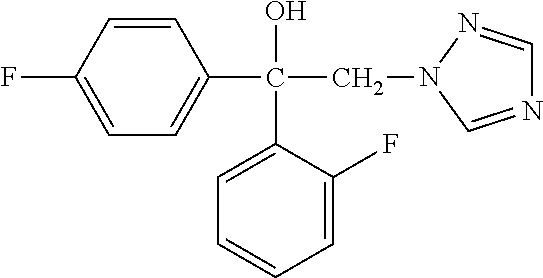Controlling charcoal rot with flutriafol
a flutriafol and charcoal rot technology, applied in the field of compound flutriafol, can solve the problems of plant death, plant stunting and chlorotic, plant death, etc., and achieve the effect of prolonging the control
- Summary
- Abstract
- Description
- Claims
- Application Information
AI Technical Summary
Benefits of technology
Problems solved by technology
Method used
Image
Examples
example 1
[0104]Inhibition of Macrophomina phaseolina (charcoal rot) was tested in the following example: The flutriafol composition used in the example was TOPGUARD (125 g / L flutriafol SC), a commercially available product.
[0105]Each pathogen was grown out on fresh potato dextrose agar (commercial PDA), assessed and used to seed 2× autoclaved rice for inoculums development. At 7-10 days, two infested rice grains with the pathogen was placed at equal distances on flutriafol-amended PDA and incubated at 27-29° C. Mycelial colony diameter from each rice grain was measured at 1, 3, 5 and 7 days from grain placement. The included tables and data sets illustrate the differences in mycelia growth in response to various concentrations of the fungicide.
TABLE 1Inhibition of Macrophomina phaseolina by flutriafol at 1, 3, 5 and 7 days.ApplicationDia (mm)Dia (mm)Dia (mm)Dia (mm)TreatmentRate (ppm)Frequency1 day3 days5 days7 days1. Untreatedn / a28.24040402. flutriafol2501x00003. flutriafol1001x00004. flutr...
example 2
[0106]The determination of the efficacy and selectivity of flutriafol when applied pre plant incorporated, and post plant drip to strawberry for control of charcoal rot was tested in the following example:
[0107]This experiment was conducted at a site with a history of charcoal rot.
[0108]Soil was a Pismo Loamy Sand with a pH of 5.4, Organic matter of 0.7% and a CEC of 9.9. This experiment was set up as a randomized complete block with four replications. Plots were a single row 3.33 feet wide and 35 feet long on raised plastic lined beds. Plot site was a conventional strawberry field and the trial was established May 4. Prior to planting the susceptible variety Portola, RHYME (a commercially available flutriafol 250 g / l SC formulation), was sprayed over the top of the bed with 0.26 lbs.ai per acre (291.4 g active ingredient per hectare; g / ha) at 50 gallons (189.27 litres) per acre of water volume (Application I) on May 28 and incorporated approximately 3 inches deep with a rototiller....
PUM
| Property | Measurement | Unit |
|---|---|---|
| volume | aaaaa | aaaaa |
| time | aaaaa | aaaaa |
| cultivation area | aaaaa | aaaaa |
Abstract
Description
Claims
Application Information
 Login to View More
Login to View More - R&D
- Intellectual Property
- Life Sciences
- Materials
- Tech Scout
- Unparalleled Data Quality
- Higher Quality Content
- 60% Fewer Hallucinations
Browse by: Latest US Patents, China's latest patents, Technical Efficacy Thesaurus, Application Domain, Technology Topic, Popular Technical Reports.
© 2025 PatSnap. All rights reserved.Legal|Privacy policy|Modern Slavery Act Transparency Statement|Sitemap|About US| Contact US: help@patsnap.com

